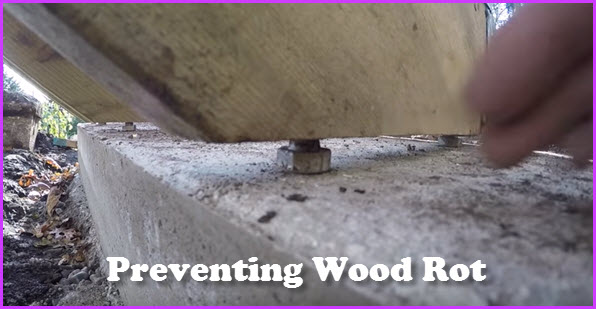.
Water Rots Wood ! – Your Job Is To Prevent It
Any place moisture can seep in and remain there for a length of time, you are going to have wood rot.
So the trick is to either protect the wood from the moisture or provide a means for the wood to dry out.
Let's start at the house wall where you attach the deck.
Has the wall a waterproof membrane and cladding to protect it?
If so You can lag bolt your deck rib joist to the existing wall. The trick here is to put 1/2 “spacers between the wall cladding and the rim joist to prevent a water trap, allowing any moisture at the wall to dry out.
If not you need some felt paper or peal and stick on the wall before you lag the rim joist to the wall, then before the deck boards go down you need a 4″ x 4″ metal flashing on top of the rim joist and then 8″ to 12″ of peal and stick up the wall. The wall cladding will lap on to this in the future and water running down the wall will follow the metal flashing and drip out under the deck.
Next look at the beams that will be supporting the deck. These beams if made from multiple layers will rot out first before anything else because the moisture flows down between the layers and that space has no way to dry out between rain storms. The trick here is to put peal and stick membrane on top of the beams and then protect that membrane with a metal cap flashing. Now you can install the joists.
The next spot to consider is the tops of each joist. Water gets between the deck boards and joist where again it has no way to dry out quick enough. So the best thing to do here is put strips of peal and stick on top of each joist. Make sure it is wider than the joist.
The life of the deck also depends on the deck board materials you choose.
Posts, beams, and joists should be pressure treated. Now you have a choice for the deck boards.
Spruce, pine, fir will last 10 to 15 years. Cedar 5 to 10 years longer. I've never use redwood but it lasts longer still. I've seen pressure treated wood last over 25 years (you will probably have to sand it smooth after 10 years). Then you have a variety of artificial board (check the manufacturers literature for lifespans hear.
You could also put plywood down with a vinyl membrane on top (lasts about 15 years).
There are a couple of other areas to consider, and they are the topic of the video on the next page.
.
Next Page »
Pages: 1 2
